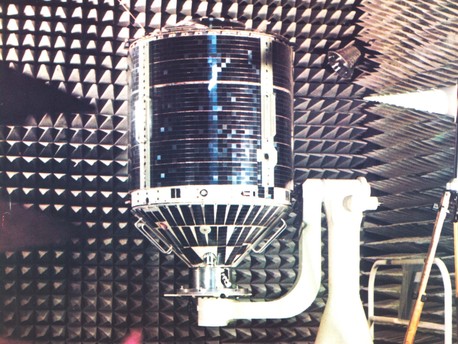Space Pioneers
Space History: Germany's First Satellite
 © Messerschmitt-Bölkow-Blohm
|
The photo shows AZUR, still on Earth, in an anechoic chamber. Here, the performance data for the on-board antennas and the reflection characteristics of the entire satellite were determined.
AZUR – also known as 'German Research Satellite-1' (GRS-1) – had a mass of 150 pounds, a length of 45 inches and a diameter of 23 inches. It was placed in a highly elliptical polar orbit – the nearest point to Earth (perigee) of its orbit was 243 miles from Earth, while its furthest point from Earth (apogee) was 2,000 miles. AZUR's orbital inclination with respect to the Equator was 103 degrees and each orbit took a little more than two hours.
A relatively short but successful excursion into space
To carry out seven carefully chosen experiments, scientific equipment weighing a total of 36 pounds was housed on board AZUR. It was used to investigate cosmic radiation and the way it interacted with Earth's magnetosphere, with the upper atmosphere and, in particular, with the Van Allen belt. AZUR was also used to conduct research into the Aurora Borealis (northern lights) and the variation in solar wind during solar eruptions.
On June 29, 1970 the connection to AZUR was lost for unknown reasons. It is assumed that radiation damaged the data transmission system. Although the planned service life of one year was not reached, instead lasting just 233 days, the project was nonetheless seen as a great scientific and technological success for Germany – the country had taken its first step into space.
German Aerospace Center
Space Pioneers
Space History: Germany's First Satellite
 © Messerschmitt-Bölkow-Blohm
|
The photo shows AZUR, still on Earth, in an anechoic chamber. Here, the performance data for the on-board antennas and the reflection characteristics of the entire satellite were determined.
AZUR – also known as 'German Research Satellite-1' (GRS-1) – had a mass of 150 pounds, a length of 45 inches and a diameter of 23 inches. It was placed in a highly elliptical polar orbit – the nearest point to Earth (perigee) of its orbit was 243 miles from Earth, while its furthest point from Earth (apogee) was 2,000 miles. AZUR's orbital inclination with respect to the Equator was 103 degrees and each orbit took a little more than two hours.
A relatively short but successful excursion into space
To carry out seven carefully chosen experiments, scientific equipment weighing a total of 36 pounds was housed on board AZUR. It was used to investigate cosmic radiation and the way it interacted with Earth's magnetosphere, with the upper atmosphere and, in particular, with the Van Allen belt. AZUR was also used to conduct research into the Aurora Borealis (northern lights) and the variation in solar wind during solar eruptions.
On June 29, 1970 the connection to AZUR was lost for unknown reasons. It is assumed that radiation damaged the data transmission system. Although the planned service life of one year was not reached, instead lasting just 233 days, the project was nonetheless seen as a great scientific and technological success for Germany – the country had taken its first step into space.
German Aerospace Center






